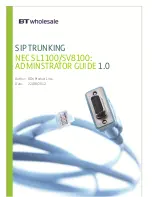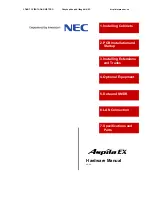
Chapter 6 Server
X2002 User’s Guide
129
channel request. But if you use the side B setting,
X
will response the
Y
with the
recommendation for another channel like channel 2.
Figure 53
Avoid Voice Channel Collision in Q.SIG
RTP
When you make a VoIP call using SIP, the RTP (Real Time Transport Protocol) is
used to handle voice data transfer. See RFC 1889 for details on RTP.
NAT
Network Address Translation (NAT) replaces an IP address used inside one
network with a different IP address that is used within another network.
Peer-to-Peer
Peer-to-peer networking has a number of participants whose devices assume the
roles of both client and server. Although they are interconnected across existing
network lines and hardware, they do not require a central server to manage their
data nor do they behave strictly as clients. All participants in a peer-to-peer
network can provide data to the others (like a server) while simultaneously
receiving data from them (like a client). This type of distributed networking relies
on the computing resources of each participant to create and maintain the data
swarm. As such, a participant with limited resources can dramatically impact the
efficiency of a small peer-to-peer network for the worse; fortunately, as the
network grows in size the weakest links are rapidly overshadowed by the bigger,
faster participants.
6.1.3 Before You Begin
Before you start configuring FXO/FXS/BRI/PRI on your X2002, you should install
corresponding interface cards on your X2002.
Q.SIG
T1/E1
PBX
X. Channel Request (1)
Y. Channel Request (1)
Y. Channel Request (1)
Y. Channel Response (2)
Side A
Side B
Summary of Contents for X2002
Page 2: ......
Page 24: ...Table of Contents X2002 User s Guide 24...
Page 25: ...25 PART I User s Guide...
Page 26: ...26...
Page 40: ...Chapter 2 How It Works X2002 User s Guide 40...
Page 99: ...99 PART II Technical Reference...
Page 100: ...100...
Page 124: ...Chapter 5 Network Deployment X2002 User s Guide 124...
Page 166: ...Chapter 7 Auto Provision X2002 User s Guide 166...
Page 170: ...Chapter 8 QoS X2002 User s Guide 170...
Page 248: ...Chapter 16 Click To Talk Group X2002 User s Guide 248...
Page 252: ...Chapter 17 Group Access Code X2002 User s Guide 252...
Page 304: ...Chapter 19 Auto Attendant X2002 User s Guide 304...
Page 312: ...Chapter 20 LCR X2002 User s Guide 312...
Page 346: ...Chapter 22 Call Services X2002 User s Guide 346...
Page 380: ...Chapter 25 Status Observation X2002 User s Guide 380...
Page 402: ...Chapter 27 Call Detail Record CDR X2002 User s Guide 402...
Page 410: ...Chapter 28 ACD Logs X2002 User s Guide 410...
Page 416: ...Chapter 29 Administrator Accounts X2002 User s Guide 416...
Page 424: ...Chapter 30 Diagnostics X2002 User s Guide 424...
Page 426: ...Chapter 31 X2002 User s Guide 426...
Page 446: ...Chapter 32 Remote Management X2002 User s Guide 446...
Page 448: ...Chapter 33 TFTP Management X2002 User s Guide 448...
Page 462: ...Chapter 35 License Control X2002 User s Guide 462...
Page 482: ...Chapter 36 Web Portal X2002 User s Guide 482...
Page 508: ...Chapter 39 Product Specifications X2002 User s Guide 508...
Page 548: ...Appendix C Legal Information X2002 User s Guide 548...
Page 562: ...Index X2002 User s Guide 562...



































